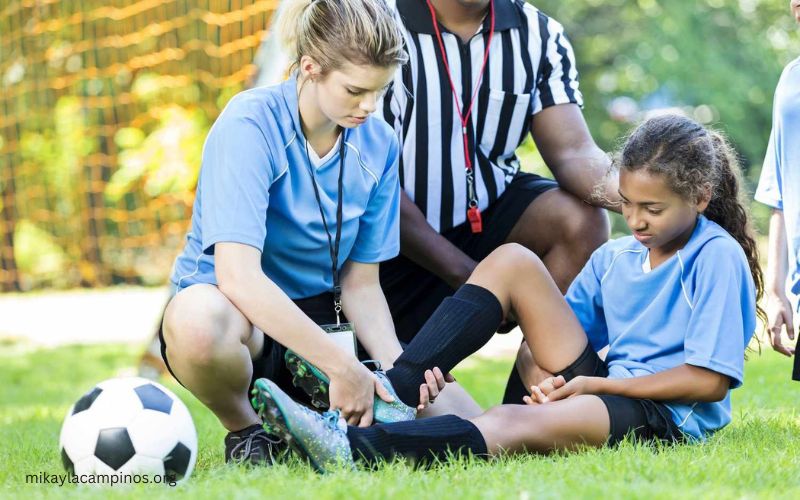Sports are an integral part of a healthy lifestyle, offering numerous physical and mental benefits. However, with the thrill of competition and physical exertion comes the risk of Injury. Whether you’re a professional athlete or a weekend warrior, understanding common sports injuries is crucial for preventing and managing them effectively. In this article, we’ll explore various types of injuries, their impact, and the importance of injury prevention. Additionally, we’ll reveal which choice is not a common sports injury, shedding light on less frequently encountered conditions.
Common sports injuries
Engaging in sports can lead to a range of injuries in sports, depending on the activity and the level of intensity. Some of the most common sports injuries include:
- Sprains and Strains
- Sprains occur when ligaments (connective tissues that join bones) are stretched or torn, often affecting the ankles, knees, or wrists.
- Strains involve the stretching or tearing of muscles or tendons (tissues that connect muscles to bones), commonly affecting the hamstrings, quadriceps, or calf muscles.
- Fractures
- Fractures refer to broken bones, which can occur due to direct impact or excessive stress on the bone.
- Common fracture sites include the wrists, arms, ankles, and legs.
- Dislocations
- Dislocations occur when a bone is forced out of its normal position in a joint, such as the shoulder, elbow, or knee.
- Concussions
- Concussions are a type of traumatic brain injury caused by a blow to the head or a sudden jerking motion, often seen in contact sports like football, soccer, or boxing.
- Tendinitis
- Tendinitis is the inflammation of a tendon, typically caused by overuse or repetitive motion.
- Common areas affected include the shoulder (rotator cuff tendinitis), elbow (tennis elbow), or knee (jumper’s knee).
- Shin Splints
- Shin splints are a painful condition caused by inflammation of the muscles, tendons, and bone tissue around the shin area, often affecting runners or dancers.
Understanding the impact of these injuries is crucial for proper management and recovery.
Understanding the impact of sports injuries
Sports injuries can have far-reaching consequences beyond physical discomfort. They can lead to:
- Prolonged absence from sports activities: Depending on the severity of the injury, athletes may need to take a break from training or competition, potentially affecting their performance and progress.
- Emotional distress: Injuries can be psychologically challenging, leading to feelings of frustration, anxiety, or even depression, especially for athletes who derive a sense of identity from their sport.
- Financial implications: For professional athletes, injuries can result in lost income, medical expenses, and potential loss of sponsorships or endorsements.
- Long-term effects: Some injuries, if not properly treated, can lead to chronic issues or permanent disabilities, impacting an athlete’s quality of life.
Recognizing the potential impact of sports injuries underscores the importance of injury prevention and proper management.
The importance of injury prevention
Preventing sports injuries should be a top priority for athletes of all levels. By taking proactive measures, you can reduce the risk of sustaining injuries and maximize your performance potential. Injury prevention strategies include:
- Proper warm-up and cool-down routines: Gradually increasing your heart rate, stretching, and preparing your muscles before exercise can help prevent strains and other overuse injuries.
- Strength and conditioning training: Building muscle strength, flexibility, and endurance through targeted exercises can improve your body’s ability to handle the demands of your sport.
- Appropriate gear and equipment: Wearing properly fitted protective gear, such as helmets, pads, or braces, can help minimize the risk of injuries during contact sports or high-impact activities.
- Gradual progression: Increasing the intensity, duration, or difficulty of your training gradually can help your body adapt and reduce the likelihood of overuse injuries.
- Listening to your body: Pay attention to any pain, discomfort, or fatigue, and adjust your training accordingly to prevent further injury.
By prioritizing injury prevention, you can enjoy the benefits of sports while minimizing the risks and potential setbacks associated with injuries.
Identifying and treating common sports injuries
Early recognition and proper treatment of sports injuries are crucial for a successful recovery. Here are some common injuries and their recommended management strategies:
- Sprains and Strains
- Immediate treatment: Rest, ice, compression, and elevation (RICE) to reduce swelling and pain.
- Follow-up care: Physical therapy, stretching, and strengthening exercises to regain range of motion and muscle strength.
- Fractures
- Immediate treatment: Immobilization, ice, and medical attention to assess the extent of the fracture and determine the appropriate treatment plan (e.g., cast, surgery).
- Follow-up care: Physical therapy and rehabilitation exercises to restore strength and mobility once the fracture has healed.
- Dislocations
- Immediate treatment: Seek medical attention to have the joint properly realigned and stabilized.
- Follow-up care: Physical therapy and exercises to regain joint mobility and strength.
- Concussions
- Immediate treatment: Remove the athlete from play, seek medical evaluation, and follow a gradual return-to-play protocol.
- Follow-up care: Cognitive rest and gradual reintroduction of physical activity under medical supervision.
- Tendinitis
- Immediate treatment: Rest, ice, and anti-inflammatory medications to reduce inflammation and pain.
- Follow-up care: Physical therapy, stretching, and strengthening exercises to address muscle imbalances and improve flexibility.
- Shin Splints
- Immediate treatment: Rest, ice, and over-the-counter pain medication to alleviate discomfort.
- Follow-up care: Addressing biomechanical issues (e.g., improper footwear, training surfaces), stretching, and strengthening exercises.
Seeking prompt medical attention and following a structured rehabilitation plan are essential for a successful recovery and preventing further complications.
Which choice is not a common sports injury?
Among the options presented, the choice that is not a common sports injury is:
Appendicitis
Appendicitis is an inflammatory condition of the appendix, a small pouch-like structure attached to the first part of the large intestine. It is not directly related to sports or physical activities but rather a medical condition that requires prompt treatment, often involving surgical removal of the appendix.
While appendicitis can occur in athletes, it is not considered a common sports injury. Sports injuries typically involve musculoskeletal structures like bones, joints, muscles, tendons, and ligaments, which are more susceptible to trauma or overuse during physical activities.
Less common sports injuries
While the injuries discussed earlier are among the most prevalent in sports, there are other less common injuries that athletes should be aware of:
- Compartment Syndrome: This condition occurs when excessive pressure builds up within a muscle compartment, potentially leading to nerve damage and impaired blood flow.
- Stress Fractures: These are tiny cracks in the bone, often caused by repetitive stress or overuse, and can occur in weight-bearing bones like the shin, foot, or hip.
- Labral Tears: These involve tears in the ring of cartilage (labrum) that surrounds the shoulder or hip joint, commonly seen in throwing or twisting sports.
- Achilles Tendon Rupture: A complete or partial tear of the Achilles tendon, which connects the calf muscle to the heel bone, can occur during sudden movements or overuse.
- Meniscus Tear: The meniscus is a cartilage disc in the knee joint that can tear due to twisting or impact, often requiring surgical repair.
While less common, these injuries can be just as debilitating and may require specialized treatment and rehabilitation protocols.
Sports injury prevention tips
Preventing sports injuries should be a top priority for athletes of all levels. Here are some effective tips to help you stay injury-free:
- Proper Warm-up and Cool-down: Dedicate time to gradually warm up your muscles before physical activity and cool down afterward to prevent strains and promote recovery.
- Strength and Flexibility Training: Incorporate exercises that target muscle strength, balance, and flexibility into your routine to improve overall conditioning and reduce the risk of injuries.
- Wear Appropriate Gear: Invest in high-quality, properly fitted protective equipment, such as helmets, pads, and supportive footwear, to minimize the impact of collisions or falls.
- Listen to Your Body: Pay attention to any pain, discomfort, or fatigue, and adjust your training accordingly to prevent overuse injuries.
- Cross-Training: Engage in a variety of activities to work different muscle groups and avoid repetitive stress on specific body parts.
- Adequate Rest and Recovery: Allow your body sufficient time to recover between intense training sessions or competitions to prevent overtraining and burnout.
- Proper Technique and Form: Work with coaches or trainers to ensure you are using proper technique and form during your sport or exercise routine to reduce the risk of injury.
- Hydration and Nutrition: Maintain proper hydration and a balanced diet to support your body’s recovery and performance.
By incorporating these preventive measures into your routine, you can significantly reduce the likelihood of sustaining sports injuries and enjoy your chosen activities with confidence.
The role of proper training and warm-up exercises
Proper training and warm-up exercises play a crucial role in preventing sports injuries. Here’s why they are essential:
- Warm-up Exercises:
- Gradually increase body temperature and heart rate, preparing your muscles for physical activity.
- Enhance blood flow and oxygen delivery to working muscles, improving their flexibility and reducing the risk of strains or tears.
- Activate the neuromuscular system, improving coordination and reaction times, which can help prevent accidents or collisions.
- Strength Training:
- Builds muscle strength and endurance, reducing the risk of overuse injuries and improving overall stability and balance.
- Targets specific muscle groups used in your sport, ensuring they are adequately prepared for the demands of the activity.
- Strengthens connective tissues like tendons and ligaments, making them more resistant to sprains or tears.
- Flexibility Training:
- Improves range of motion and joint mobility, allowing for more fluid and efficient movement patterns.
- Reduces muscle tightness and tension, decreasing the likelihood of strains or overuse injuries.
- Enhances overall body awareness and control, which can help prevent accidents or falls.
- Sport-Specific Training:
- Mimics the movements, intensities, and demands of your sport, preparing your body for the specific challenges it will face.
- Develops muscle memory and improves reaction times, reducing the risk of injury during gameplay or competition.
- Identifies and addresses any weaknesses or imbalances that could contribute to injury risk.
By incorporating proper warm-up exercises, strength training, flexibility training, and sport-specific drills into your routine, you can significantly reduce the likelihood of sustaining sports injuries and optimize your performance potential.
Conclusion
Sports injuries are an unfortunate reality for athletes of all levels, but understanding and taking proactive measures can help mitigate their impact. From sprains and strains to fractures and concussions, recognizing common sports injuries and their proper management is crucial for a successful recovery. However, it’s important to note that appendicitis, while a serious medical condition, is not considered a common sports injury.
Injury prevention should be a top priority, and strategies like proper warm-up and cool-down routines, strength and conditioning training, appropriate gear, and gradual progression can go a long way in reducing the risk of injuries. Additionally, seeking prompt medical attention and following a structured rehabilitation plan are essential for a successful recovery and preventing further complications.
Remember, your health and well-being should always come first. By prioritizing injury prevention and proper management, you can continue to enjoy the physical and mental benefits of sports while minimizing the risks and potential setbacks associated with injuries.
If you’re an athlete or participate in sports regularly, consider consulting with a sports medicine specialist or certified athletic trainer. They can provide personalized guidance on injury prevention strategies, proper training techniques, and rehabilitation protocols tailored to your specific sport and needs.



